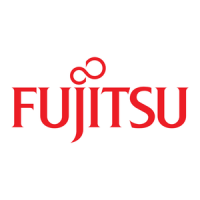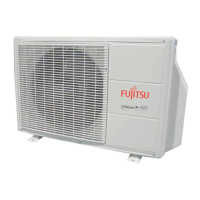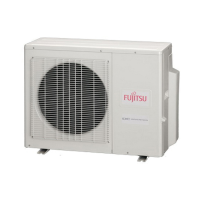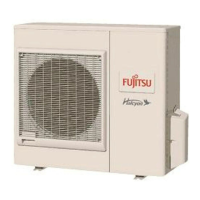Do you have a question about the Fujitsu AOU18RD and is the answer not in the manual?
Explains DANGER, WARNING, and CAUTION labels and symbols used in the manual.
Stresses consulting professionals for unit installation, repair, and moving.
Warns against direct airflow, inserting objects into the unit, and continuing operation during malfunctions.
Cautions regarding ventilation, placement, covering, water exposure, and operating with wet hands.
Advises on power-off for extended periods, battery handling, and infant safety.
Covers filter use, avoiding obstructions, placement near heat, and connection valve safety.
Unit starts automatically in Heating, Cooling, Dry, or Monitor modes based on settings.
Adjusts thermostat gradually during operation for sleep comfort and auto shut-off.
Enables convenient control of air conditioner operations via remote.
Louvers swing automatically to distribute air throughout the room.
Indoor unit's intake grille is removable for easy cleaning and maintenance.
Air filter treated to resist mildew, ensuring cleaner use and easier care.
Reduces indoor unit airflow for quieter operation when QUIET mode is selected.
Directs powerful warm airflow downwards to warm feet quickly and efficiently.
Identifies and describes the parts of the indoor unit.
Identifies and describes the parts of the outdoor unit.
Lists and explains the buttons on the remote control unit.
Describes the TIME ADJUST, ACL, and TEST RUN buttons on the rear of the remote.
Explains the various indicators shown on the remote control unit's display.
Instructions on turning on the power and checking the circuit breaker.
Step-by-step guide for loading batteries into the remote control unit.
How to set the current time on the remote control unit using specific buttons.
Explains how to point the remote at the signal receiver and expected feedback.
Instructions for mounting the remote control unit holder.
How to select modes like AUTO, HEAT, COOL, DRY, FAN using buttons.
Instructions for adjusting the thermostat setting for heating and cooling.
How to select fan speeds including AUTO, HIGH, MED, LOW, and QUIET.
How the unit automatically switches modes based on room temperature.
Adjusting temperature settings in Fahrenheit increments (e.g., 2°F, 4°F higher/lower).
How to stop the unit using the START/STOP button.
Details on AUTO, Cooling, Dry, and Fan modes, including specific conditions.
Step-by-step guide to set single ON or OFF timers for operation.
Instructions for setting integrated ON and OFF timer sequences within 24 hours.
How to cancel any set timer operation and return to normal mode.
Steps to adjust an existing timer setting.
How to manually stop the unit even when a timer is active.
How to alter mode, fan speed, or thermostat while a timer is set.
Explains how program timers integrate ON/OFF operations in a 24-hour cycle.
How to start the sleep timer function while the unit is operating or stopped.
How to modify the sleep timer duration using the SET TIME buttons.
Procedure to cancel the sleep timer and revert to normal operation.
How to stop the unit manually while the sleep timer is active.
Details how the sleep timer modifies thermostat settings to prevent discomfort.
How to adjust the up/down airflow direction using the remote control.
How to manually adjust the left/right airflow direction using louvers.
Warnings about inserting fingers, manual louver adjustment, and infant care.
How to activate the automatic swing function for airflow distribution.
How to stop the automatic swing function.
Explains the swing ranges for different modes and notes on temporary stops.
Instructions for operating the unit using controls on the main unit when remote is lost.
Emphasizes disconnecting power before cleaning due to fan hazards.
Instructions for wiping the indoor unit with damp and dry cloths.
Guidance on operating in fan mode to dry internal parts before long periods of non-use.
Advises disconnecting power for safety when the unit is not used for extended periods.
Recommends regular professional maintenance for optimal performance.
Step-by-step guide on how to open, unlock, clean, and close the intake grille.
Warns against operating the unit with the intake grille open due to accident risk.
Instructions for removing, cleaning, drying, and replacing the air filter.
Immediate action for malfunctions (smell, etc.) - stop, disconnect power, consult service.
Explains reasons for delayed operation, like compressor protection.
Addresses sounds like water flowing, coolant, or slight squeaking during operation.
Explains potential smells from room odors or condensation.
Explains mist/steam from cooling or heating operations, including defrosting.
Covers issues like temporary low fan speed, stops during defrost, or quiet modes.
Explains water production from the outdoor unit, especially during automatic defrosting.
Addresses the outdoor unit continuing to run for defrosting after heating stops.
Checks for power failure, blown fuse, tripped breaker, or power switch position.
Checks filter, intake/outlet blockage, temperature settings, and open windows.
Checks for SUPER QUIET mode and remote battery status.
What to do if problems persist or burning smells/flashing lights occur.
Explains how heating performance reduces in cold weather and suggests auxiliary heating.
How the unit restarts automatically after a power failure.
Details on how the unit restores previous settings and louvre positions after power loss.
Explains the automatic defrosting feature during low outdoor temperatures and its indicator.
Specifies the recommended operating ranges for indoor and outdoor conditions.
Warns about potential damage from operating outside specified temperature and humidity ranges.
Explains DANGER, WARNING, and CAUTION labels and symbols used in the manual.
Stresses consulting professionals for unit installation, repair, and moving.
Warns against direct airflow, inserting objects into the unit, and continuing operation during malfunctions.
Cautions regarding ventilation, placement, covering, water exposure, and operating with wet hands.
Advises on power-off for extended periods, battery handling, and infant safety.
Covers filter use, avoiding obstructions, placement near heat, and connection valve safety.
Unit starts automatically in Heating, Cooling, Dry, or Monitor modes based on settings.
Adjusts thermostat gradually during operation for sleep comfort and auto shut-off.
Enables convenient control of air conditioner operations via remote.
Louvers swing automatically to distribute air throughout the room.
Indoor unit's intake grille is removable for easy cleaning and maintenance.
Air filter treated to resist mildew, ensuring cleaner use and easier care.
Reduces indoor unit airflow for quieter operation when QUIET mode is selected.
Directs powerful warm airflow downwards to warm feet quickly and efficiently.
Identifies and describes the parts of the indoor unit.
Identifies and describes the parts of the outdoor unit.
Lists and explains the buttons on the remote control unit.
Describes the TIME ADJUST, ACL, and TEST RUN buttons on the rear of the remote.
Explains the various indicators shown on the remote control unit's display.
Instructions on turning on the power and checking the circuit breaker.
Step-by-step guide for loading batteries into the remote control unit.
How to set the current time on the remote control unit using specific buttons.
Explains how to point the remote at the signal receiver and expected feedback.
Instructions for mounting the remote control unit holder.
How to select modes like AUTO, HEAT, COOL, DRY, FAN using buttons.
Instructions for adjusting the thermostat setting for heating and cooling.
How to select fan speeds including AUTO, HIGH, MED, LOW, and QUIET.
How the unit automatically switches modes based on room temperature.
Adjusting temperature settings in Fahrenheit increments (e.g., 2°F, 4°F higher/lower).
How to stop the unit using the START/STOP button.
Details on AUTO, Cooling, Dry, and Fan modes, including specific conditions.
Step-by-step guide to set single ON or OFF timers for operation.
Instructions for setting integrated ON and OFF timer sequences within 24 hours.
How to cancel any set timer operation and return to normal mode.
Steps to adjust an existing timer setting.
How to manually stop the unit even when a timer is active.
How to alter mode, fan speed, or thermostat while a timer is set.
Explains how program timers integrate ON/OFF operations in a 24-hour cycle.
How to start the sleep timer function while the unit is operating or stopped.
How to modify the sleep timer duration using the SET TIME buttons.
Procedure to cancel the sleep timer and revert to normal operation.
How to stop the unit manually while the sleep timer is active.
Details how the sleep timer modifies thermostat settings to prevent discomfort.
How to adjust the up/down airflow direction using the remote control.
How to manually adjust the left/right airflow direction using louvers.
Warnings about inserting fingers, manual louver adjustment, and infant care.
How to activate the automatic swing function for airflow distribution.
How to stop the automatic swing function.
Explains the swing ranges for different modes and notes on temporary stops.
Instructions for operating the unit using controls on the main unit when remote is lost.
Emphasizes disconnecting power before cleaning due to fan hazards.
Instructions for wiping the indoor unit with damp and dry cloths.
Guidance on operating in fan mode to dry internal parts before long periods of non-use.
Advises disconnecting power for safety when the unit is not used for extended periods.
Recommends regular professional maintenance for optimal performance.
Step-by-step guide on how to open, unlock, clean, and close the intake grille.
Warns against operating the unit with the intake grille open due to accident risk.
Instructions for removing, cleaning, drying, and replacing the air filter.
Immediate action for malfunctions (smell, etc.) - stop, disconnect power, consult service.
Explains reasons for delayed operation, like compressor protection.
Addresses sounds like water flowing, coolant, or slight squeaking during operation.
Explains potential smells from room odors or condensation.
Explains mist/steam from cooling or heating operations, including defrosting.
Covers issues like temporary low fan speed, stops during defrost, or quiet modes.
Explains water production from the outdoor unit, especially during automatic defrosting.
Addresses the outdoor unit continuing to run for defrosting after heating stops.
Checks for power failure, blown fuse, tripped breaker, or power switch position.
Checks filter, intake/outlet blockage, temperature settings, and open windows.
Checks for SUPER QUIET mode and remote battery status.
What to do if problems persist or burning smells/flashing lights occur.
Explains how heating performance reduces in cold weather and suggests auxiliary heating.
How the unit restarts automatically after a power failure.
Details on how the unit restores previous settings and louvre positions after power loss.
Explains the automatic defrosting feature during low outdoor temperatures and its indicator.
Specifies the recommended operating ranges for indoor and outdoor conditions.
Warns about potential damage from operating outside specified temperature and humidity ranges.
| Type | Split System |
|---|---|
| Cooling Capacity | 5.0 kW |
| Heating Capacity | 5.6 kW |
| Power Supply | 220-240 V, 50 Hz |
| Refrigerant | R410A |
| Outdoor Unit Noise Level | 52 dB(A) |











